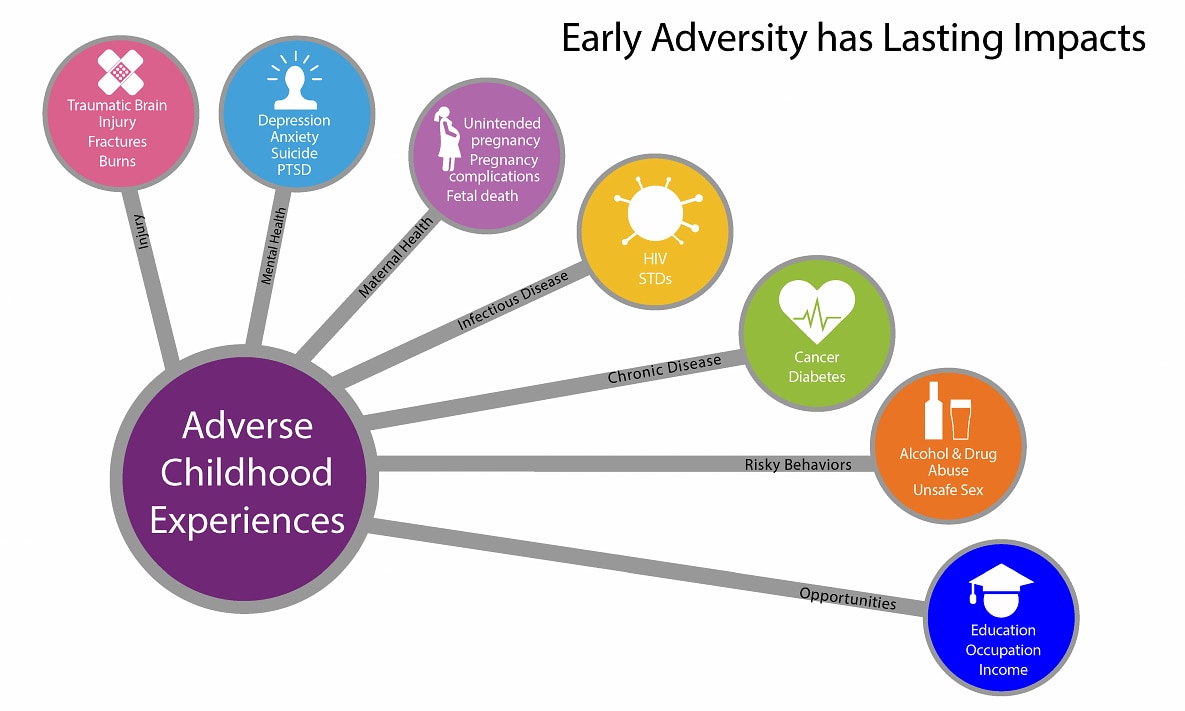Rocky Mountain Prevention Research Center’s Innovative Approach to Prevent Adverse Childhood Experiences in Their Community
Adverse childhood experiences (ACEs) can have lasting effects on individuals and future generations.
Adverse childhood experiences, known as ACEs, are modifiable risk factors, such as divorce, domestic violence, abuse, and neglect, that can have a lasting effect on a person’s overall health. The impact of ACEs lasts long after childhood and can lead to negative health outcomes for the individual and, possibly, for their children.
Long alternative description of the above diagram
In Colorado’s San Luis Valley (SLV), 60% of adults reported experiencing one or more ACEs, and 45% of adults reported being emotionally or verbally abused by a household member before the age of 18. Unfortunately, many of the effects of ACEs are passed to the next generation of children in the SLV. Community members see this as a significant problem, and they are working with the Rocky Mountain Prevention Research Center (RMPRC) to take action. RMPRC has developed a multi-level, multigeneration, partner-directed framework called STANCE (Linking Systems To Address ACEs iN Childhood Early On) to prevent the persistence of ACEs across generations.
RMPRC used an innovative mapping process to identify the specific strengths and challenges of ACEs interventions in the SLV.
Before implementing STANCE, RMPRC used the Innovation Corps (I-Corps) method to better understand the challenges and gaps in existing ACEs interventions in the SLV. I-Corps is a method that helps communities create an ecosystem map of local resources and assets. RMPRC used I-Corps to create a map of organizations addressing ACEs in the SLV. With the map, they identified stakeholders for key-informant interviews, such as individuals from government, healthcare, early childhood education, and community-based organization sectors. They reached out to more than 60 organizations and conducted 37 stakeholder interviews. They asked stakeholders about barriers and facilitators to implementing ACEs interventions in the community.
RMPRC used the findings from their I-Corps research to improve the STANCE framework.
Key-informant interviews helped RMPRC adapt the STANCE framework, making it more relevant for families in the SLV. Below are a few findings and resulting adaptations from the I-Corps research.
Finding
Finding
Adaptation
Adaptation
Participants emphasized the importance of trusted messengers to engage families in support services. Some community organizations have mental health professionals who have worked in the SLV for years and have established trust with many families.
Participants emphasized the importance of trusted messengers to engage families in support services. Some community organizations have mental health professionals who have worked in the SLV for years and have established trust with many families.
RMPRC modified their implementation strategy to include these professionals as implementers of STANCE.
RMPRC modified their implementation strategy to include these professionals as implementers of STANCE.
In other similar interventions, families have felt treated as simply an “entity needing a resource.” Families told interviewees, “I’ve already heard this— you’re no different from the last person I spoke to.”
In other similar interventions, families have felt treated as simply an “entity needing a resource.” Families told interviewees, “I’ve already heard this— you’re no different from the last person I spoke to.”
RMPRC adapted STANCE to take an assets-based approach. For example, parenting programs shifted the focus from the challenges parents faced to reinforcing and building on their strengths.
RMPRC adapted STANCE to take an assets-based approach. For example, parenting programs shifted the focus from the challenges parents faced to reinforcing and building on their strengths.
Educators in early childhood education centers shared how some of the behavioral challenges they see among children has led to staff burnout and frequent turnover. One stakeholder said, “I’ve also seen more of the physicality, crossing the lines. It’s really increased aggressiveness.”
Educators in early childhood education centers shared how some of the behavioral challenges they see among children has led to staff burnout and frequent turnover. One stakeholder said, “I’ve also seen more of the physicality, crossing the lines. It’s really increased aggressiveness.”
RMPRC added a pyramid model to STANCE that addresses problem behavior through enhancing children’s social-emotional development.
RMPRC added a pyramid model to STANCE that addresses problem behavior through enhancing children’s social-emotional development.
Finding
Participants emphasized the importance of trusted messengers to engage families in support services. Some community organizations have mental health professionals who have worked in the SLV for years and have established trust with many families.
In other similar interventions, families have felt treated as simply an “entity needing a resource.” Families told interviewees, “I’ve already heard this— you’re no different from the last person I spoke to.”
Educators in early childhood education centers shared how some of the behavioral challenges they see among children has led to staff burnout and frequent turnover. One stakeholder said, “I’ve also seen more of the physicality, crossing the lines. It’s really increased aggressiveness.”
Adaptation
RMPRC modified their implementation strategy to include these professionals as implementers of STANCE.
RMPRC adapted STANCE to take an assets-based approach. For example, parenting programs shifted the focus from the challenges parents faced to reinforcing and building on their strengths.
RMPRC added a pyramid model to STANCE that addresses problem behavior through enhancing children’s social-emotional development.
RMPRC looks to the future with a network of partners.
As the project moves into its final years, RMPRC is evaluating the effectiveness and sustainability of the STANCE intervention with families attending early childhood education centers throughout the SLV. RMPRC staff are also working with their Community Advisory Board and other community stakeholders to incorporate lessons learned to improve STANCE and better meet the needs of children and families in the SLV. Looking ahead, they hope to take STANCE to a larger scale, beginning with translating the framework to another rural community.
The Rocky Mountain Prevention Research Center is one of 26 Prevention Research Centers (PRCs) supported by the Centers for Disease Control and Prevention (CDC) for the 2019–2024 funding cycle.
